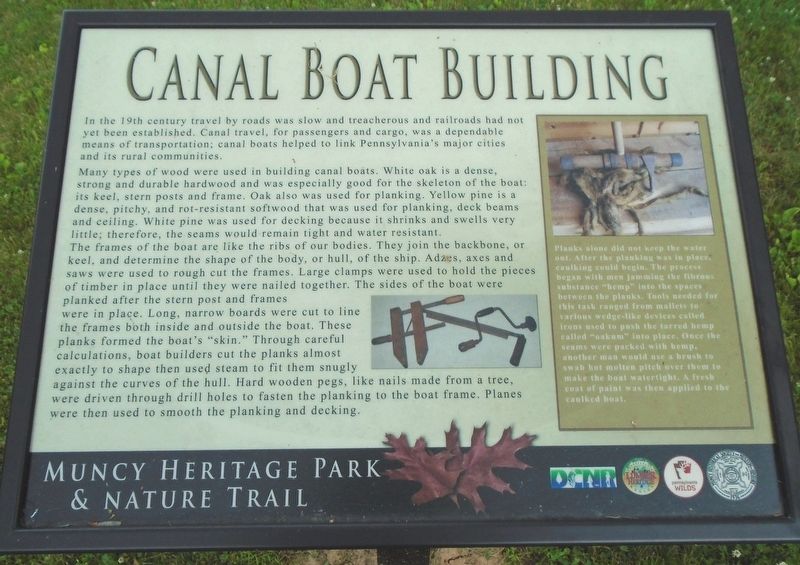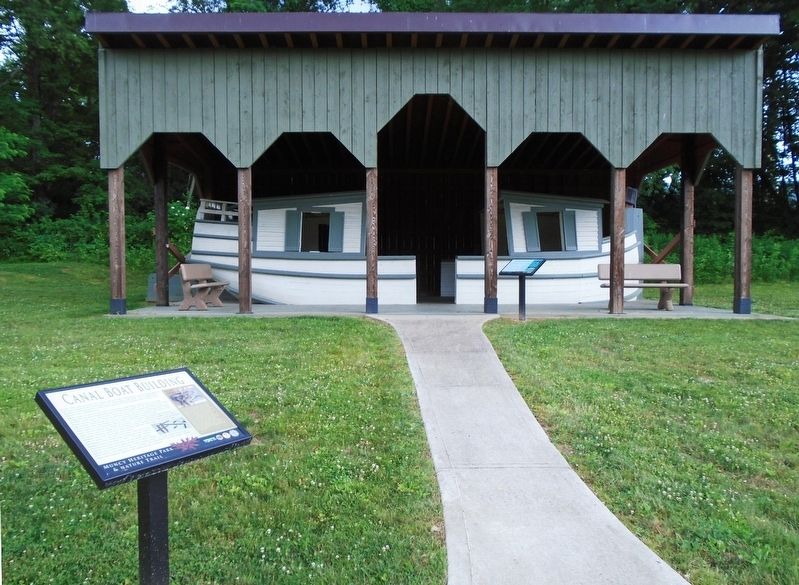Muncy in Lycoming County, Pennsylvania — The American Northeast (Mid-Atlantic)
Canal Boat Building
In the 19th century travel by roads was slow and treacherous and railroads had not yet been established. Canal travel, for passengers and cargo, was a dependable means of transportation; canal boats helped to link Pennsylvania's major cities and its rural communities.
Many types of wood were used in building canal boats. White oak is a dense, strong and durable hardwood and was especially good for the skeleton of the boat: its keel, stern posts and frame. Oak also was used for planking. Yellow pine is a dense, pitchy, and rot-resistant softwood that was used for planking, deck beams and ceiling. White pine was used for decking because it shrinks and swells very little; therefore, the seams would remain tight and water resistant.
The frames of the boat are like the ribs of our bodies. They join the backbone, or keel, and determine the shape of the body, or hull, of the ship. Adzes, axes and saws were used to rough cut the frames. Large clamps were used to hold the pieces of timber in place until they were nailed together. The sides of the boat were planked after the stern post and frames were in place. Long, narrow boards were cut to line the frames both inside and outside the boat. These planks formed the boat's "skin." Through careful calculations, boat builders cut the planks almost exactly to shape then used steam to fit them snugly against the curves of the hull. Hard wooden pegs, like nails made from a tree, were driven through drill holes to fasten the planking to the boat frame. Planes were then used to smooth the planking and decking.
[Right inset text reads]
Planks alone did not keep the water out. After the planking was in place, caulking could begin. The process began with men jamming the fibrous substance "hemp" into the spaces between the planks. Tools needed for this task ranged from mallets to various wedge-like devices called irons used to push the tarred hemp called "oakum" into place. Once the seams were packed with hemp, another man would use a brush to swab hot molten pitch over them to make the boat watertight. A fresh coat of paint was then applied to the caulked boat.
Erected by Muncy Historical Society and Museum of History, PA DCNR, PA Lumber Heritage Region, and PA Wilds.
Topics. This historical marker is listed in these topic lists: Industry & Commerce • Man-Made Features • Parks & Recreational Areas • Waterways & Vessels.
Location. 41° 11.531′ N, 76° 48.105′ W. Marker is in Muncy, Pennsylvania, in Lycoming County. Marker is at the Muncy Heritage Park and Nature Trail, off Pepper Street, near the Canal Boat shelter. Touch for map. Marker is in this post office area: Muncy PA 17756, United States of America. Touch for directions.
Other nearby markers. At least 8 other markers are within one mile of this marker, measured as the crow flies. Canal Boats (a few steps from this marker); Fisher Pond (within shouting distance of this marker); How a Lock Works (about 300 feet away, measured in a direct line); Welcome to Port Penn (about 400 feet away); Drinking Well (about 400 feet away); The Lock-tender and His House (about 400 feet away); Nature's Highway (about 500 feet away); Riebsam House (approx. one mile away). Touch for a list and map of all markers in Muncy.
Also see . . .
1. The Archaeology of 19th Century Canal Boats. Illinois Department of Natural Resources website entry (Submitted on July 26, 2018, by William Fischer, Jr. of Scranton, Pennsylvania.)
2. Muncy Historical Society PA. Website homepage (Submitted on July 26, 2018, by William Fischer, Jr. of Scranton, Pennsylvania.)
Credits. This page was last revised on May 26, 2023. It was originally submitted on July 26, 2018, by William Fischer, Jr. of Scranton, Pennsylvania. This page has been viewed 244 times since then and 36 times this year. Photos: 1, 2. submitted on July 26, 2018, by William Fischer, Jr. of Scranton, Pennsylvania.

